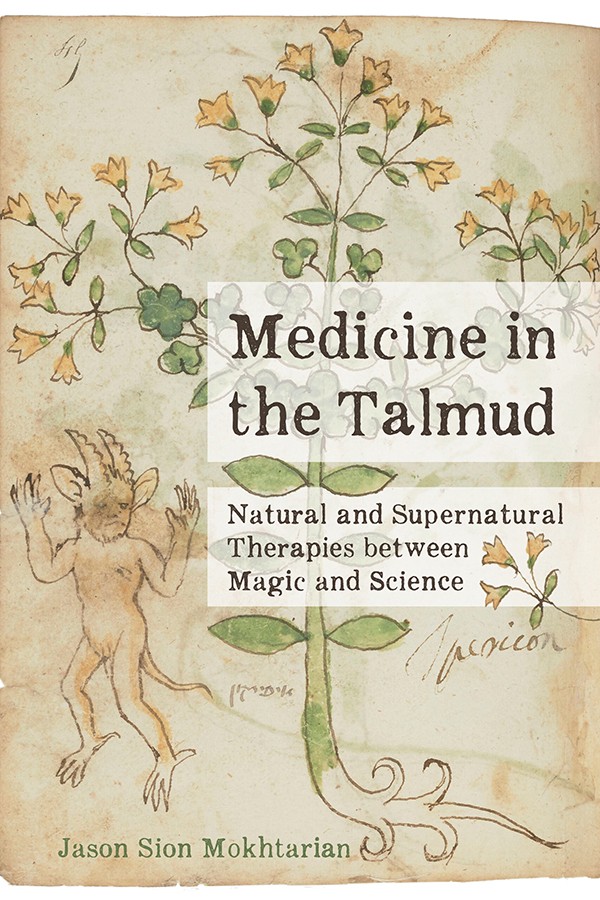Ancient Jewish text preserves real-world remedies
By Kate Blackwood
One typically turns to rabbis for spiritual advice and guidance on Jewish law, but the Babylonian Talmud, a collection of rabbinic writings produced by Jews living in ancient Persia, 224-651 C.E., also contains a great deal of medical knowledge, according to a new book by a Cornell author.
In “Medicine in the Talmud: Natural and Supernatural Therapies Between Magic and Science,” Jason Mokhtarian argues that the rabbis subscribed to a common medical culture they shared with pagans, Christians, Mandaeans and other therapeutic schools of thought, while at the same time making it their own.
“The therapies are odd and inherently interesting texts, and always lead to the best class discussions,” said Mokhtarian, associate professor of Near Eastern studies and the Herbert and Stephanie Neuman Chair in Jewish Studies and Iranian Studies. He came to appreciate the complexity of medical material in the Babylonian Talmud, also known as the Bavli, while teaching the text to undergraduates.
“Compared to other Jewish cultures, the Babylonian Talmud downplays the role of God and sin in human illness and health, and instead promotes the idea that God authorized humans to heal themselves using the natural world that He created, such as plants and animals,” Mokhtarian wrote.
He spoke with the College of Arts and Sciences about the book.
Question: What is your favorite remedy in the Bavli?
A: There are many interesting ones, but one of my favorites is the following (magical) therapy for a one-day fever, which involves trapping an ant in a tube and reciting a phrase that transfers the fever to the ant:
Abaye said: Mother said to me, For a one-day fever, take a silver zuz coin and go to a salt pit and weigh its weight in salt, and [then] tie [the salt] at the empty space of the neck with a yellow string. If not, one should sit at a crossroads and when one sees a large ant carrying something, one should take [the ant] and insert it into a bronze tube, and close it up with lead and seal it with sixty sealings, and shake it and scatter it, and say to [the ant]: “My load upon you, your load upon me.”
Q: Your book often mentions medicine and magic in close proximity, including in the title. What is the connection in the Bavli?
A: Magic and medicine were intertwined phenomena in late antiquity, and ancient Jews did not always make a distinction between the two categories, like we often do today. There has of course been a long debate among scholars in various disciplines regarding the proper definitions and stakes of using the category “magic” to study ancient cultures. Magic is a large category which includes amulets, spells, voodoo dolls, astrology, exorcisms, among other things – including healing and medicine.
For the most part, scholars of rabbinic literature research medicine as a subcategory of magic. On the one hand, there is a logic to this choice, since healing was certainly one of the core aims of ancient magical texts and artifacts. Ancient Jews believed in the power and efficacy of sympathetic rituals and potent words and objects to control injurious supernatural demons and bodily illnesses.
Yet as I argue in the book, it is equally important to remember that in the Talmud not all magic is medicine, and not all medicine is magic. In other words, scholars who subsume Talmudic medicine under the category of magic tend to ignore the therapies that have few, if any, identifiable magical elements, such as those that use natural ingredients to be consumed or applied to the body. It is these latter therapies – the more empirical ones, so to speak – that actually make up the majority of the Talmudic medical tradition.
Q: Today, in the age of advanced medicine, is there any good practical medical advice to be found in the Babylonian Talmud? Or any that’s especially off-base or downright dangerous?
A: Historically, the rabbis had different criteria and ideas regarding how to determine whether a certain therapy was effective or not. Presumably, the rabbis believed the therapies worked, otherwise they would not have preserved them in the Talmud. There is no reason to dismiss out of hand that some of the more empirical therapies (e.g., potions, drugs, salves, etc.), based on a detailed knowledge of the medicinal properties of specific plants and animal parts, may have been effective in treating certain afflictions.
That said, for the most part, one today has to assume that most (though not all) of the archaic therapies in the Talmud would not be deemed effective by contemporary scientific standards. In fact, it is this impression that the therapies are magical, superstitious and ineffective that led to a long-standing marginalization of the therapies throughout Jewish history, beginning soon after the editing of the Talmud and continuing up until today. One sees this skeptical attitude toward Talmudic medicine already in the writings of Rav Sherira Gaon, the head of the Pumbedita academy in the 10th century, who says simply that “our sages were not physicians.”
Kate Blackwood is a writer for the College of Arts and Sciences.
Media Contact
Get Cornell news delivered right to your inbox.
Subscribe

